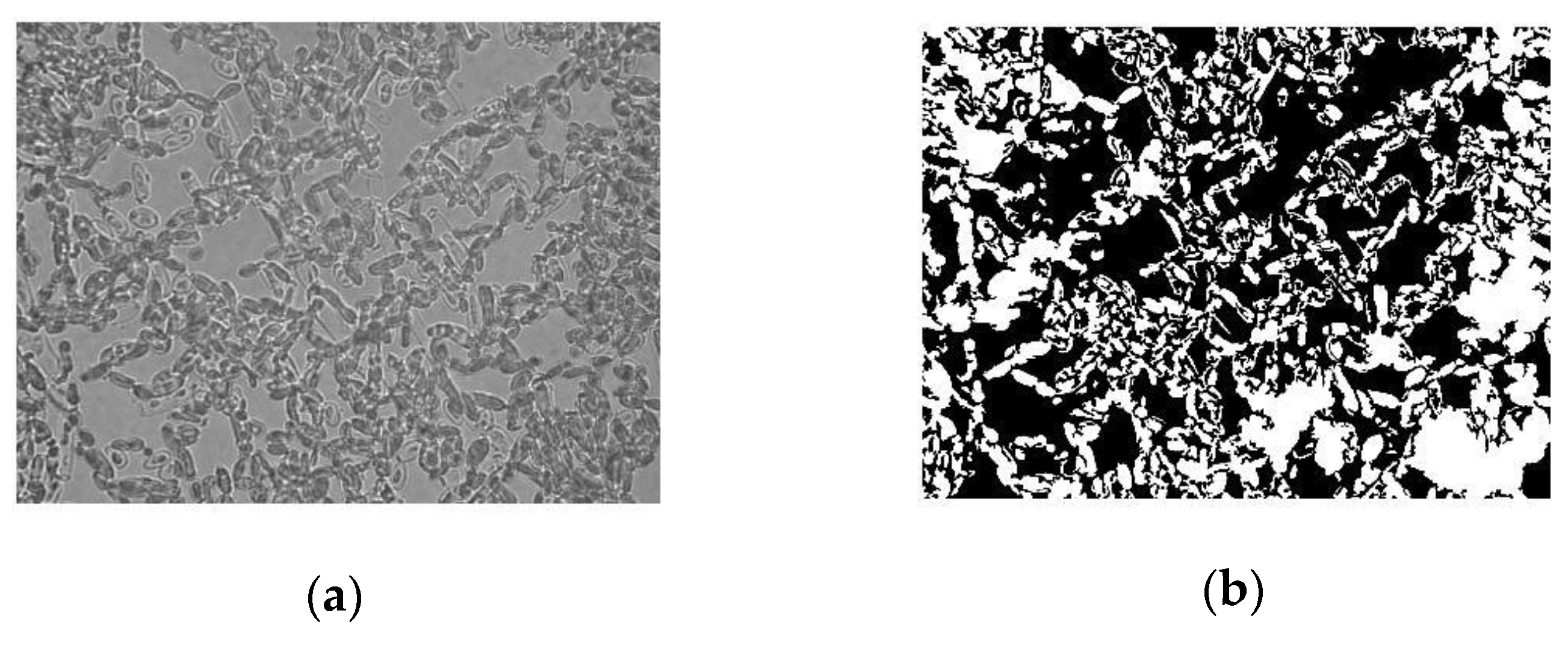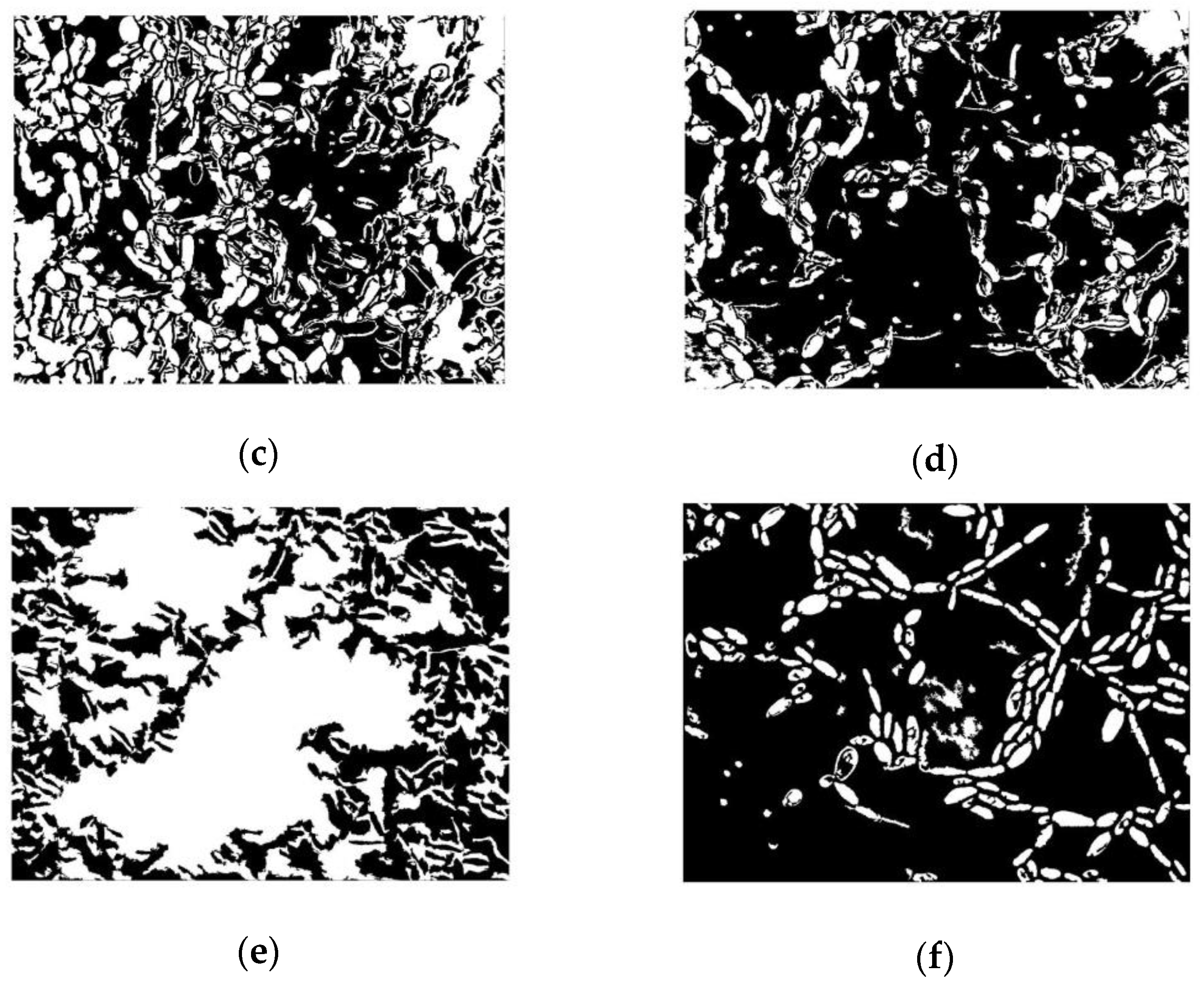Yarrowia lipolytica Adhesion and Immobilization onto Residual Plastics
Abstract
1. Introduction
2. Materials and Methods
2.1. Materials
2.2. Adhesion Surfaces
2.3. Strain, Media, and Culture Conditions
2.4. Adhesion Assays
2.4.1. Samples Preparation
2.4.2. Adhesion Assays
2.4.3. Image Analysis
2.4.4. Pronase Treatment
2.4.5. Contact Angle Measurement
2.5. Testing the Immobilization of Cell Debris in Solid Surfaces
2.5.1. Production of Cells with Enzymatic Activity (Cell Debris)
2.5.2. Determination of Enzymatic Activity
3. Results
3.1. Solid Surface Characterization
3.2. Adhesion of Cells on Solid Surfaces
3.3. Application of Cells Immobilized on Polymer Surfaces
4. Conclusions
Author Contributions
Funding
Conflicts of Interest
References
- Chiba, S.; Saito, H.; Fletcher, R.; Yogi, T.; Kayo, M.; Miyagi, S.; Ogido, M.; Fujikura, K. Human footprint in the abyss: 30 year records of deep-sea plastic debris. Mar. Policy 2018, 96, 204–212. [Google Scholar] [CrossRef]
- Yoshida, S.; Hiraga, K.; Takehana, T.; Taniguchi, I.; Yamaji, H.; Maeda, Y.; Toyohara, K.; Miyamoto, K.; Kimura, Y.; Oda, K. A bacterium that degrades and assimilates poly (ethylene terephthalate). Science 2016, 351, 1196–1199. [Google Scholar] [CrossRef]
- Austin, H.P.; Allen, M.D.; Donohoe, B.S.; Rorrer, N.A.; Kearns, F.L.; Silveira, R.L.; Pollard, B.C.; Dominick, G.; Duman, R.; El Omari, K.; et al. Characterization and engineering of a plastic-degrading aromatic polyesterase. Proc. Natl. Acad. Sci. USA 2018, 115, E4350–E4357. [Google Scholar] [CrossRef] [PubMed]
- Berlowska, J.; Kregiel, D.; Ambroziak, W. Enhancing adhesion of yeast brewery strains to chamotte carriers through aminosilane surface modification. World J. Microbiol. Biotechnol. 2013, 29, 1307–1316. [Google Scholar] [CrossRef] [PubMed]
- Adamczak, M.; Bednarski, W. Enhanced activity of intracellular lipases from Rhizomucor miehei and Yarrowia lipolytica by immobilization on biomass support particles. Process Biochem. 2004, 39, 1347–1361. [Google Scholar] [CrossRef]
- Ban, K.; Kaieda, M.; Matsumoto, T.; Kondo, A.; Fukuda, H. Whole cell biocatalyst for biodiesel fuel production utilizing Rhizopus oryzae cells immobilized within biomass support particles. Biochem. Eng. J. 2001, 8, 39–43. [Google Scholar] [CrossRef]
- Lehocký, M.; Amaral, P.F.F.; Sťahel, P.; Coelho, M.A.Z.; Barros-Timmons, A.M.; Coutinho, J.A.P. Deposition of Yarrowia lipolytica on plasma prepared teflonlike thin films. Surf. Eng. 2008, 24, 23–27. [Google Scholar] [CrossRef]
- Lehocký, M.; Amaral, P.F.F.; Sťahel, P.; Coelho, M.A.Z.; Barros-Timmons, A.M.; Coutinho, J.A.P. Preparation and characterization of organosilicon thin films for selective adhesion of Yarrowia lipolytica yeast cells. J. Chem. Technol. Biotechnol. 2007, 82, 360–366. [Google Scholar] [CrossRef]
- Dufrêne, Y.F. Sticky microbes: Forces in microbial cell adhesion. Trends Microbiol. 2015, 23, 376–382. [Google Scholar] [CrossRef]
- Hermansson, M. The DLVO theory in microbial adhesion. Colloids Surf. B 1999, 14, 105–119. [Google Scholar] [CrossRef]
- Rijnaarts, H.H.M.; Norde, W.; Bouwer, E.J.; Lyklema, J.; Zehnder, A.J.B. Reversibility and mechanism of bacterial adhesion. Colloids Surf. B 1995, 4, 5–22. [Google Scholar] [CrossRef]
- Barth, G.; Gaillardin, C. Physiology and genetics of the dimorphic fungus Yarrowia lipolytica. FEMS Microbiol. Rev. 1997, 19, 219–237. [Google Scholar] [CrossRef] [PubMed]
- Fickers, P.; Fudalej, F.; Nicaud, J.M.; Destain, J.; Thonart, P. Selection of new over-producing derivatives for the improvement of extracellular lipase production by the non-conventional yeast Yarrowia lipolytica. J. Biotech. 2005, 115, 379–386. [Google Scholar] [CrossRef] [PubMed]
- Amaral, P.F.F.; Lehocky, M.; Barros-Timmons, A.M.V.; Rocha-Leão, M.H.M.; Coelho, M.A.Z.; Coutinho, J.A.P. Cell surface characterization of Yarrowia lipolytica IMUFRJ 50682. Yeast 2006, 23, 867–877. [Google Scholar] [CrossRef]
- Ota, Y.; Gomi, K.; Kato, S.; Sugiura, T.; Minoda, Y. Purification and some properties of cell-bound lipase from Saccharomycopsis lipolytica. Agric. Biol. Chem. 1982, 46, 2885–2893. [Google Scholar] [CrossRef]
- Nunes, P.; Martins, A.B.; Brigida, A.I.; Miguez Da Rocha Leao, M.H.M.; Amaral, P. Intracellular lipase production by Yarrowia lipolytica using different carbon sources. Chem. Eng. Trans. 2014, 38, 421–426. [Google Scholar]
- Fraga, J.L.; Penha, A.C.B.; Pereira, A.S.; Silva, K.A.; Akil, E.; Torres, A.G.; Amaral, P.F.F. Use of Yarrowia lipolytica Lipase Immobilized in Cell Debris for the Production of Lipolyzed Milk Fat (LMF). Int. J. Mol. Sci. 2018, 19, 3413. [Google Scholar] [CrossRef]
- López-García, J.; Bílek, F.; Lehocký, M.; Junkar, I.; Mozetič, M.; Sowe, M. Enhanced printability of polyethylene through air plasma treatment. Vacuum 2013, 95, 43–49. [Google Scholar] [CrossRef]
- Haegler, A.N.; Mendonça-Haegler, L.C. Yeast from marine and estuarine waters with different levels of pollution in the State of Rio de Janeiro, Brazil. Appl. Environ. Microbiol. 1981, 41, 173–178. [Google Scholar] [CrossRef]
- Rosenberg, M. Bacterial Adherence to Polystyrene: A Replica Method of Screening for Bacterial Hydrophobicity. Appl. Environ. Microbiol. 1981, 42, 375–377. [Google Scholar] [CrossRef] [PubMed]
- Freire, M.G.; Dias, A.M.A.; Coelho, M.A.Z.; Coutinho, J.A.P.; Marrucho, I.M. Aging mechanisms of perfluorocarbon emulsions using image analysis. J. Colloid Interface Sci. 2005, 286, 224–232. [Google Scholar] [CrossRef] [PubMed]
- Tae-Hyun, K.; OH, Y.S.; Kim, S.J. The Possible Involvement of the Cell Surface in Alinphatic Hydrocarbon Utilization by an Oil-Degrading Yeast, Yarrowia lipolytica 180. J. Microbiol. Biotechnol. 2000, 10, 333–337. [Google Scholar]
- van Oss, C.J.; Chaudhury, M.K.; Good, R.J. Monopolar surfaces. Adv. Coll. Int. Sci. 1987, 28, 35–64. [Google Scholar] [CrossRef]
- van Oss, C.J. Hydrophobicity of biosurfaces-origin, quantitative determination and interaction energies. Coll. Surf. B 1995, 5, 91–110. [Google Scholar] [CrossRef]
- van der Mei, H.C.; Bos, R.; Busscher, H.J. A reference guide to microbial cell surface hydrophobicity based on contact angles. Coll. Surf. B 1998, 11, 213–221. [Google Scholar] [CrossRef]
- Rijnaarts, H.H.M.; Norde, W.; Lyklema, J.; Zehnder, A.J.B. The isoelectric point of bacteria as an indicator for the presence of cell surface polymers that inhibit adhesion. Coll. Surf. B 1995, 4, 191–197. [Google Scholar] [CrossRef]
- Aguedo, M.; Waché, Y.; Belin, J.M.; Teixeira, J.A. Surface properties of Yarrowia lipolytica and their relevance to γ-decalactone formation from methyl ricinoleate. Biotechnol. Lett. 2005, 27, 417–422. [Google Scholar] [CrossRef][Green Version]




| Testing Liquid | γ [mJ/m2] | γLW [mJ/m2] | γAB [mJ/m2] | γ+ [mJ/m2] | γ− [mJ/m2] |
|---|---|---|---|---|---|
| Water (W) | 72.8 | 21.8 | 51.0 | 25.5 | 25.5 |
| Formamide (F) | 58.0 | 39.0 | 19.0 | 2.28 | 39.6 |
| Methylene iodide (M) | 50.8 | 50.8 | 0 | 0 | 0 |
| Surface | Contact Angle (°) | γtot | γLW | γAB | γ + | γ− | ||
|---|---|---|---|---|---|---|---|---|
| W | F | M | [mJ/m2] | [mJ/m2] | [mJ/m2] | [mJ/m2] | [mJ/m2] | |
| Polystyrene | 90.5 ± 0.6 | 27.5 ± 0.8 | 73.5 ± 1.1 | 89.8 | 45.2 | 44.6 | 27.1 | 18.3 |
| Glass | 16.6 ± 0.1 | 47.6 ± 0.3 | 51.8 ± 2.4 | 72.5 | 35.6 | 37.0 | 17.4 | 19.6 |
| Teflon | 97.3 ± 0.6 | 57.3 ± 2.9 | 81.3 ± 2.5 | 49.5 | 30.2 | 19.4 | 14.3 | 6.5 |
| PET | 77.8 ± 1.3 | 58.2 ± 1.8 | 20.5 ± 2.2 | 50.4 | 47.6 | 2.8 | 0.2 | 8.1 |
| pH | Cell Adhesion Occupied Area/Total Area | |||||
|---|---|---|---|---|---|---|
| Polystyrene | PET | Glass | ||||
| W29 | IMUFRJ | W29 | IMUFRJ | W29 | IMUFRJ | |
| 3.0 | 0.28 | 0.43 | 0.11 | 0.30 | 0.24 | 0.44 |
| 5.0 | 0.18 | 0.36 | 0.21 | 0.29 | 0.22 | 0.31 |
| 7.0 | 0.22 | 0.45 | 0.20 | 0.17 | 0.12 | 0.24 |
| 9.0 | 0.20 | 0.61 | 0.13 | 0.19 | 0.12 | 0.35 |
| Material | Cell Adhesion Occupied Area/Total Area | |||
|---|---|---|---|---|
| 10−4 M | 10−1 M | |||
| before Pronase Treatment | after Pronase Treatment | before Pronase Treatment | after Pronase Treatment | |
| Polystyrene | 0.78 ± 0.08 | 0.05 ± 0.01 | 0.52 ± 0.06 | 0.07 ± 0.01 |
| PET | - | - | 0.17 ± 0.06 | 0.07 ± 0.04 |
| Glass | 0.34 ± 0.09 | 0.35 ± 0.08 | 0.25 ± 0.10 | 0.41 ± 0.05 |
| Teflon | 0.52 ± 0.07 | 0.39 ± 0.03 | 0.54 ± 0.04 | 0.40 ± 0.06 |
| Material | Lipase Activity (μmol p-Nitrophenol/min/g Cell Debris) | |
|---|---|---|
| before Adhesion of Cell Debris | after Adhesion of Cell Debris | |
| Y. lipolytica cell debris | 33.66 | - |
| Polystyrene | 0 | 21.85 ± 6.25 |
| PET | 0 | 11.45 ± 1.08 |
© 2020 by the authors. Licensee MDPI, Basel, Switzerland. This article is an open access article distributed under the terms and conditions of the Creative Commons Attribution (CC BY) license (http://creativecommons.org/licenses/by/4.0/).
Share and Cite
Botelho, A.; Penha, A.; Fraga, J.; Barros-Timmons, A.; Coelho, M.A.; Lehocky, M.; Štěpánková, K.; Amaral, P. Yarrowia lipolytica Adhesion and Immobilization onto Residual Plastics. Polymers 2020, 12, 649. https://doi.org/10.3390/polym12030649
Botelho A, Penha A, Fraga J, Barros-Timmons A, Coelho MA, Lehocky M, Štěpánková K, Amaral P. Yarrowia lipolytica Adhesion and Immobilization onto Residual Plastics. Polymers. 2020; 12(3):649. https://doi.org/10.3390/polym12030649
Chicago/Turabian StyleBotelho, Alanna, Adrian Penha, Jully Fraga, Ana Barros-Timmons, Maria Alice Coelho, Marian Lehocky, Kateřina Štěpánková, and Priscilla Amaral. 2020. "Yarrowia lipolytica Adhesion and Immobilization onto Residual Plastics" Polymers 12, no. 3: 649. https://doi.org/10.3390/polym12030649
APA StyleBotelho, A., Penha, A., Fraga, J., Barros-Timmons, A., Coelho, M. A., Lehocky, M., Štěpánková, K., & Amaral, P. (2020). Yarrowia lipolytica Adhesion and Immobilization onto Residual Plastics. Polymers, 12(3), 649. https://doi.org/10.3390/polym12030649









